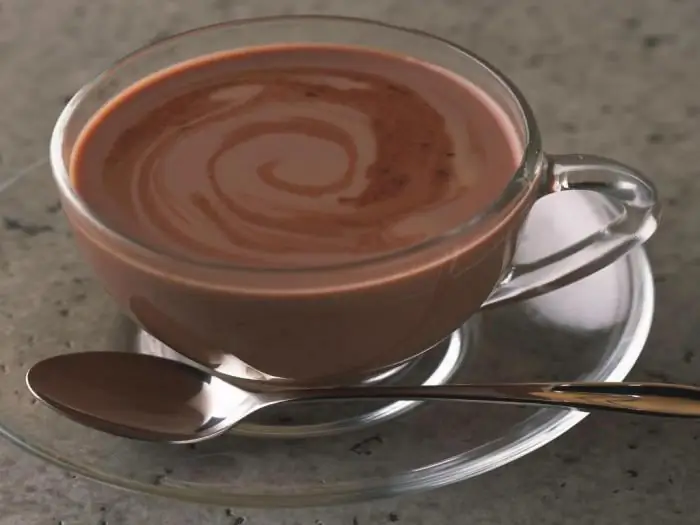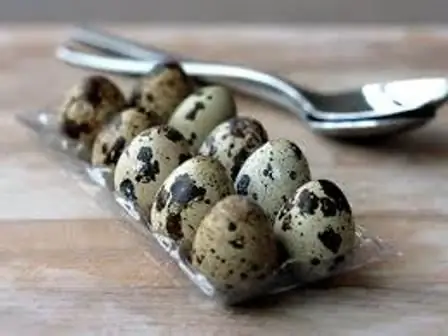2026 Author: Isabella Gilson | [email protected]. Last modified: 2025-01-23 12:50:30
In the confectionery industry, one of the main semi-finished products is chocolate icing. Traditionally, cocoa butter has been used in the production of this component. This component is not cheap, and the characteristics are very fastidious. In recent years, non-aluric and lauric type cocoa butter substitutes have been used. In the media, we are increasingly seeing controversy about whether this product is useful or harmful. Supporters and opponents of substitutes argue. Let's take a closer look at this issue.

Confectionery glaze
No confectionery factory can do without glaze production. It is used in almost all products - in various pastries, in the production of ice cream, glazed curds, sweets, cakes and many other types of sweets. Some characteristics make this frosting so popular:
- Flavoring. Thanks to the glaze treatment, the product becomes much tastier, sweeter.
- Nutritious. Sweets get extra nutritional value.
- Processing with confectionery glaze increases the shelf life of the product. Protects sweets, rolls, cookies from drying out.
Classic glaze is made by mixing several ingredients, this includes: cocoa butter or cocoa butter substitute, sugar, emulsifiers, dry milk products, flavorings. Manufacturers offer bakers and confectioners a wide range of this semi-finished product: glaze in its pure form, with various additives, inclusions, with nuts, with raisins, standard dark brown glaze or various shades and colors.

Types of fats
The use of pure cocoa butter in the production of chocolate icing is too expensive. Such an expensive type of raw material is used only by large confectionery factories. Most medium and small enterprises replace cocoa butter in the confectionery with identical - more accessible and cheaper - ingredients: substitutes, improvers. This allows us to remain competitive in the production of products, keep prices, make them more affordable for consumers. There are plenty of fats on the Russian market for the production of glaze. The entire range is divided into main groups:
- Confectionery fats.
- Tempered cocoa butter substitutes.
- Untempered cocoa butter substitutes - lauric and non-lauric.
The quality of the fat used in the production of glaze affects the nutritional value and tasteend products.

Temperable substitutes
Modern food industry uses in the production of pralines, waffle fillings, chocolate-nut pastes, candy fillings, various plastic and cream masses fats. Cocoa butter substitutes are increasingly being used for glazes.
Tempered substitutes are made using palm oil, sal tree oil, shea butter, and other exotic species that are approved by Rospotrebnadzor for use in our food industry. This raw material is used for the production of high quality chocolate icing, in the manufacture of pastries, waffle cakes, sweets (for casting cases or for glazing). Various figures are cast from chocolate icing, chocolate bars are made. Temperable substitutes have physicochemical parameters that are closest to the properties of cocoa butter itself. Their similarities are maximum.

Benefits
Tempered cocoa butter substitute has a number of positive qualities that can be attributed to the benefits of this product:
1. It has excellent taste characteristics. Complete lack of waxy taste in the mouth.
2. Low content of polyunsaturated acids, which provides high resistance to oxidation. Thanks to this, products have a long shelf life.
3. Glazed products have good hardness and gloss. According to organoleptic indicatorssuch products are very similar to those that are covered with natural glaze, where natural cocoa butter is taken as the basis.
4. In hot weather conditions, glazes based on tempered substitutes have good resistance to high temperatures. This gives the product an advantage over those coated with cocoa butter glaze.

Untempered cocoa butter equivalents
Non-lauric cocoa butter substitute is made from rapeseed, sunflower, soybean and palm oils. These equivalents are similar in composition to cocoa butter and can be mixed. It is acceptable to use various combinations with other vegetable oil, cocoa powder or milk powder. Non-lauric substitutes are used for glazing wafers, cakes, rolls, marmalade, cookies, marshmallows, for casting tiles, figurines. The advantage of the glaze is that it quickly hardens, does not require tempering.
Untempered cocoa butter substitute of lauric type has the following characteristics:
- Does not require tempering.
- Mass fraction of fat is not less than 99%.
- Made from modified vegetable oil.
- Lauric acid content is 40% by mass with or without various food additives and other ingredients
It is used for glazing curds, ice cream, cakes, rolls and other confectionery products, chocolate bars. The use of cocoa butter substitutes makes it possible to reduce the cost of products.

Lauric fats
Lauric cocoa butter substitute is used to completely replace the natural product in the manufacture of a mixture with a fat content of up to 12%. The raw materials for this species are palm kernel, coconut and other oils that have certain characteristics. Lauric fat cannot be combined with natural cocoa butter. Combination is only possible with powder.
Lauric cocoa butter substitutes are used in the production of confectionery bars, hollow chocolate figurines, super strong glazes for ice cream, cakes, marmalade, marshmallows and curd cheeses.
Benefits
Laurine cocoa butter substitutes have a number of advantages, they are ideal for making a hard glaze that has a luxurious sheen. Glazed products have a hard, but very fragile surface, which, once in the mouth, instantly melts and leaves a pleasant taste. Products are easily separated from the mold, they look very aesthetically pleasing, their surface is smooth and shiny. The glaze melts very easily and then quickly hardens. Glazed products have extended shelf life and bloom resistance (due to oxidation resistance). The tempering stage is excluded. Lauric glazes are very economical financially.

Flaws
The disadvantages of the product include the possibility of a soapy taste. This can be avoided by observing the following conditions:
- controlmicrobiological indicators of raw materials, as well as humidity;
- it is necessary to introduce antioxidants into semi-finished products;
- do not glaze confectionery, candy shells with high humidity;
- maintain a certain humidity in the confectionery shop.
When using different types of glazes (lauric and non-lauric fats), equipment must be thoroughly cleaned. Mixing the components can lead to liquefaction of the semi-finished product, in the future it hardens poorly.
Cocoa butter substitute: harmful
After the widespread use of cocoa butter substitutes, many researchers and consumers began to leave the most controversial reviews about the product. The content of palm, coconut oils in almost all confectionery products causes consumer alertness. Are they as safe for the body as the manufacturers claim?
Those who carefully monitor their diet and their he alth have long abandoned products containing palm oil, and explain this by its harmful effects on the body. Cocoa butter contains stearic, oleic, palmitic, and archaic acids. High calorie foods lead to obesity. S alt deposition begins in the body, then diseases of the genitourinary system appear.

Palm oil is used to produce lauric cocoa butter substitute. Its harm is due to the presence of saturated fats in the composition. Their frequent use causes diseases of the heart and blood vessels, atherosclerosis,thrombosis, obesity. Palm oil is not completely excreted, it accumulates in the body in the form of toxins. A plastic sticky mass closes up parts of the intestine, lumen of blood vessels, and is deposited on other organs. Palm oil prevents the absorption of some vital trace elements, such as calcium. This causes great harm to the he alth of the child. Smart parents choose a formula for feeding, where the composition does not contain palm oil. It is also a flavor enhancer, and this is highly discouraged for the body. Palm oil - and this has been proven by scientists - is the strongest carcinogen. Refractory substances retain the product for a long time, but do not have the ability to melt in our body. Take care of your he alth and always read the ingredients on the label.
Recommended:
Cocoa beans: benefits and uses. Cocoa beans: photo

The economy of many countries with a warm and humid climate is based on the production of cocoa. These trees are actively cultivated in the countries of South America, Africa and Asia. The main value is cocoa beans, which are used in the food and cosmetic industries. How they are grown, processed, what is produced from them, as well as the dangers and benefits of the product can be found in the following article
The benefits and harms of poppy. Poppy seeds: benefits and harms. Drying with poppy seeds: benefits and harms

Poppy is an amazingly beautiful flower that has earned a controversial reputation due to its controversial properties. Even in ancient Greece, people loved and revered this plant for its ability to calm the mind and heal diseases. The benefits and harms of poppy have been studied for centuries, so today so much information has been collected about it. Our distant ancestors also resorted to the help of these mysterious flowers. Unfortunately, today few people know about the healing effects that this plant has on the human body
Does cocoa have caffeine? Cocoa: he alth benefits and harms

High quality cocoa powder, made from natural cocoa beans, is rich in a variety of nutrients and elements. Today, in an age of innovation, numerous chemicals, colors and flavors are added to cocoa. Unfortunately, this not only leads to the loss of the beneficial properties of the drink, but also has a negative impact on human he alth in general
How to make cocoa from cocoa powder. How to make cocoa powder frosting

Do you know how to make cocoa from cocoa powder? If you do not own this information, then you will be very interested in the materials of this article
Boiled egg: benefits and harms. The benefits and harms of boiled chicken and quail eggs

Nutritionists are constantly arguing about what gives the body a boiled egg. The benefits and harms of this product are relative: it all depends on the state of he alth and the amount of product consumed. Today, we will be detailing the he alth benefits, nutritional value, and dietitian warnings to keep in mind. So

